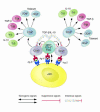Tregs and transplantation tolerance
- PMID: 15545987
- PMCID: PMC525747
- DOI: 10.1172/JCI23238
Tregs and transplantation tolerance
Abstract
The induction and maintenance of immune tolerance to transplanted tissues constitute an active process involving multiple mechanisms that work cooperatively to prevent graft rejection. These mechanisms are similar to inherent tolerance toward self antigens and have a requirement for active immunoregulation, largely T cell mediated, that promotes specific unresponsiveness to donor alloantigens. This review outlines our current understanding of the Treg subsets that contribute to allotolerance and the mechanisms by which these cells exert their effects as well as their potential for therapy.
Figures


References
-
- Lechler RI, Garden OA, Turka LA. The complementary roles of deletion and regulation in transplantation tolerance. Nat. Rev. Immunol. 2003;3:147–158. - PubMed
-
- Sakaguchi S, Sakaguchi N, Asano M, Itoh M, Toda M. Immunologic self-tolerance maintained by activated T cells expressing IL-2 receptor alpha-chains (CD25). Breakdown of a single mechanism of self-tolerance causes various autoimmune diseases. J. Immunol. 1995;155:1151–1164. - PubMed
-
- Wood KJ, Sakaguchi S. Regulatory T cells in transplantation tolerance. Nat. Rev. Immunol. 2003;3:199–210. - PubMed
-
- Rogers NJ, Lechler RI. Allorecognition. Am. J. Transplant. 2001;1:97–102. - PubMed
Publication types
MeSH terms
Substances
LinkOut - more resources
Full Text Sources
Other Literature Sources
Medical

